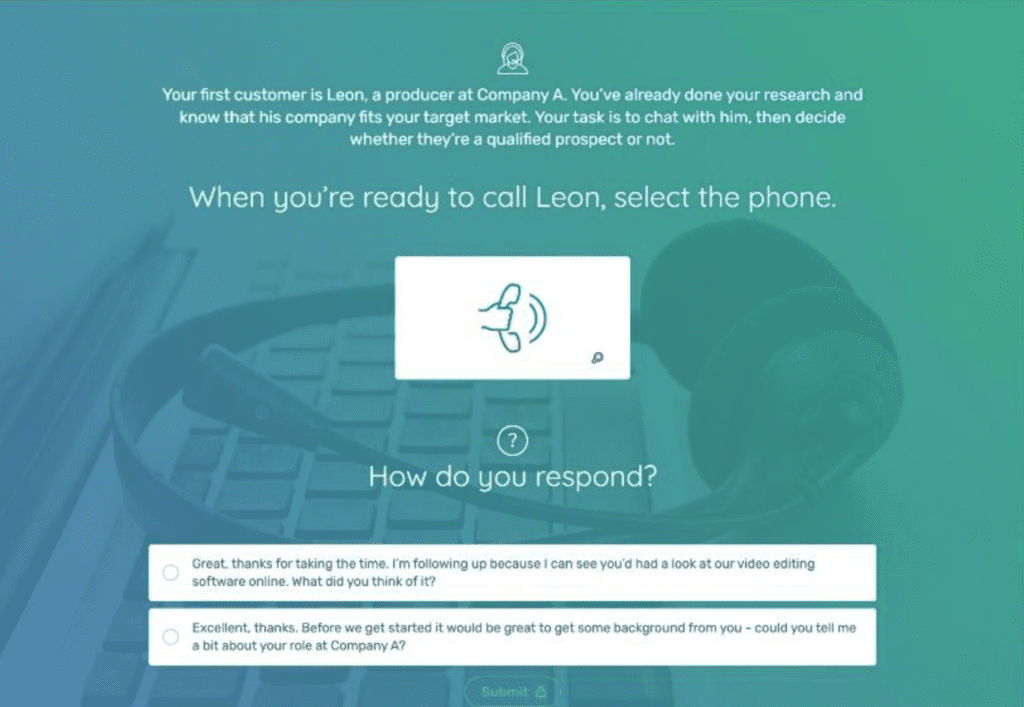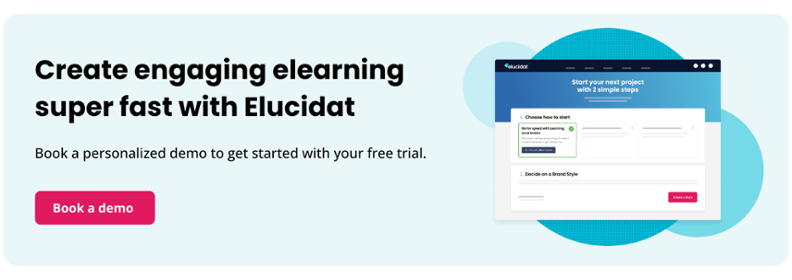Scenario-based training: A complete guide to immersive elearning
7 minute read
Nothing makes your busy employees switch off quicker than being faced with training that’s irrelevant. Want to stop them just clicking through and start getting them engaged? Make passive learning experiences a thing of the past by harnessing the power of scenario-based learning. Let’s dive into why it works and how you can use it to deliver long term impact.

Table of contents
What is scenario-based training?
Scenario-based learning brings training to life by placing learners in realistic situations and enabling them to put their knowledge and skills into action. Whether they’re building soft skills or mastering product training, learners can make decisions and see how their choices play out in a risk-free simulated environment.
It’s hands-on, people-centered, active learning that boosts competence and confidence. Leaving your learners ready to take on their work in the real world.
In essence, it’s learning by doing and it can be incredibly effective.
Why scenario-based training works
Scenario learning is proven to improve skills and increase confidence. But how does it achieve this?
Here are its 4 key benefits:
- It gives context: 38% of learners say they’re more engaged when training reflects their reality. Realistic training scenarios make learning easier to apply on the job.
- It keeps things practical: Whether you’re sharpening decision-making skills or driving behavior change, practice creates progress. Learners take action, get feedback and see the impact of their choices, so they can improve.
- It increases engagement: Humans love stories. Compelling digital storytelling immerses your learners and keeps them engaged. They’ll be eager to explore what happens next and see how their decisions affect the outcome.
- It’s a safe space to fail: Making mistakes is part of learning. With scenario-based training, people try new things without fear of real-world fallout. It’s a great way to tackle sensitive or high-risk topics too tricky to practice in person.
Key elements of effective scenario-based training
Effective scenario-based learning isn’t just about telling a good story. If you’re going to maximize the impact with immersive learning scenarios, you need some key building blocks in place.
- Realistic context: Establish scenarios and characters that are relevant to your learners. Present realistic challenges that put their skills and knowledge into practice.
- Decision points: Give learners the freedom to make choices. Let them explore different paths, experiment with their choices, and see how things play out.
- Consequences: Make sure each choice has clear, immediate consequences. This is where the learning happens – feedback is key for improvement and knowledge retention.
- Moments to reflect: Encourage learners to pause and analyze. What worked? What didn’t? What can they do better next time?
How to build a scenario-based elearning course
If you’re going to incorporate all these elements, you need a robust scenario process.
Like any digital learning project, there are 4 steps you can’t go without.
1. Capture – Start with a clear plan
Rather than diving in and risking rewriting your elearning scenarios later, take the time to make a plan.
- Understand your learning needs: Start with a clear understanding of the problem you’re solving and who you’re training. This insight will help keep you focused and shape your scenario approach to deliver maximum impact.
- Explore critical situations: Talk to your learners to uncover their key challenges and pain points, as well as what good looks like in reality. The situations they highlight will be the foundation of your scenarios.
2. Conceptualize – lead with a prototype
With the learning needs clear in your mind, you can set about generating some ideas for how they can be met with scenario-based learning.
- Determine your approach: From simple linear situations to complex, branching experiences, there are different ways to approach scenario-based learning. Choose the format that best suits your learners and training goals. Make sure your authoring tool provides the functionality you need for the approach you’ve chosen to take.
- Prototype: Whether it’s a simple wireframe or an interactive elearning walkthrough, prototyping a small piece of scenario-based learning allows you to check that you’re heading in the right direction.
3. Create – Build with confidence
Once prototyping has confirmed your thinking, it’s time to get stuck into developing your full learning experience. When designing your scenario, make sure you’re including the key elements:
- Realistic context: Select a setting, characters and situation or task that will resonate with your learners and deliver the greatest impact.
- Decision points: Map out the situation and pinpoint key decisions your learners need to make.
- Consequences: Identify the common mistakes, the impact these have and the feedback that learners will need to get back on track.
- Moments to reflect: Highlight where there’s opportunity for your learners to reflect on their own experiences and how what they’ve seen relates to their work.
For simple linear scenarios, work straight into your authoring tool. With more complex branching scenarios, it’s important to map out how this will work. It will save time in the long run and avoid headaches later.
4. Cultivate – Improve and refine
Once your scenario is built, test it with a small group of learners. Gather comments on everything – from the context to the feedback. Then refine your scenario based on their input to ensure it delivers the best results.
Explore more practical tips in our blog on designing branching scenarios.
Examples of scenario-based training done well
Ready to dive into planning your scenario-based learning? Here are five powerful elearning examples to spark your creativity.
1. Linear scenario-based learning
In this example, the learner chooses from one of two scenarios based on where they work. The linear scenario sets up a discrimination dilemma and asks the learner to investigate. They need to get input from different people, before making decisions about what to do next.

Why it works:
- In large organizations with diverse teams, one scenario is unlikely to suit all. A role selector personalizes the scenarios that learners see.
- Complex topics, such as ethics or discrimination, require multiple viewpoints and inputs into decisions.
- By allowing learners to investigate and draw their own conclusions, they’re empowered to take control of their learning journey.
2. Immersive branching video scenario
This branching simulation-based learning builds soft skills around mental health. The learner watches a video before they’re asked what they think is going on and what action they would take. Personalized results analyze the approach chosen, compares it with others’, and sets out how other approaches would have played out.

Why it works:
- Learners control the story and feel the impact of their decisions on others.
- Feedback comes at the end, making the branching seamless and the experience more authentic.
- Comparing their approach with others’ choices adds another layer of real-life learning context.
3. Audio-driven, first-person scenario
This audio-driven, first-person scenario helps salespeople learn by practicing in a simulated environment. Adding game mechanics – like points and timers – taps into a fundamental aspect of human behavior: motivation. In this case, it’s the competitive nature of salespeople.

Why it works:
- Taking a first-person perspective puts the learner in the hot seat, experiencing the scenario instead of observing it.
- Using audio keeps costs down while creating a highly engaging experience, simulating the real-world environment learners work in.
- Game elements bring a competitive edge, replicating the urgency and pressure of a fast-paced sales floor.
Want to see more examples? Read our blogs on simple branching scenarios and more complex branching, and explore some other scenario-based examples.
Common pitfalls
When done well, scenario-based learning can maximize your impact. However, to achieve this you’ll need to avoid some common pitfalls.
Overcomplicating branches
More complex “deep branching” can take learner engagement up a gear, but only if it’s thought through. Branching can quickly get out of control within a few decision points. Before you know it, you’re facing a complex build and risking errors creeping into your digital learning.
- Do balance the complexity of the scenario with the impact it will achieve.
- Don’t assume that complex branching automatically means more impact.
Lack of relevance or realism
Remember, you’re the learning expert and not the Subject Matter Expert (SME) so you won’t automatically know what scenarios work best with your learners.
- Do use focus groups and user testing to check that your scenarios are realistic.
- Don’t get carried away with developing exciting scenarios which few learners will relate to.
Forgetting feedback
While seeing the outcome of decisions can engage learners in your scenario, they can only build their critical thinking skills with feedback on their choices.
- Do provide clear feedback either after each question or at the end of the scenario.
- Don’t just show the outcome of the learner’s decisions and leave them guessing how to improve.
Summary
Scenario-based training is a powerful way to boost engagement by immersing the learners in interactive scenarios where they can apply their decision-making skills. It provides context, connects theory to practice, fosters engagement and creates a safe space to build confidence.
If you’re going to achieve this, you need a robust process for developing your training scenarios:
- Capture: Start with a clear plan based on your learners’ needs and the situations they face.
- Conceptualize: Prototype your ideas to test the direction of your scenario before full development.
- Create: Design your scenario using key elements: realistic context, decision points, consequences, and opportunities to reflect.
- Cultivate: Test and refine based on feedback to ensure maximum impact.
With the right approach, scenario-based learning can get your learners engaged and deliver real world impact.
Find about more about scenario-based learning and other ways to deliver truly engaging digital learning in our elearning best practice guide and How to create engaging elearning course.
Ready to start creating scenario-based learning experiences with impact? Book a demo of Elucidat and start your free trial today.




